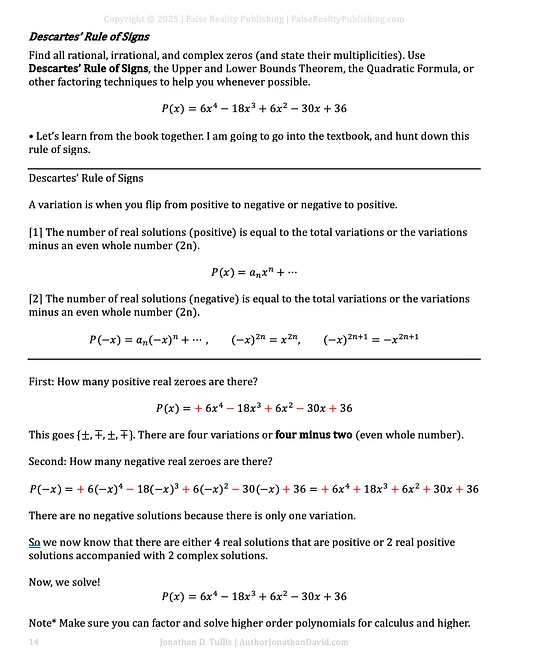Solving High-Order Polynomials Using Descartes’ Rule of Signs and Long Division
This post guides you step-by-step through how to use Descartes’ Rule of Signs, factoring, and long division to solve a fourth-degree polynomial. These techniques are foundational in algebra and essential for calculus students dealing with rational functions and polynomial division.
The Problem:
Solve
P(x) = 6x⁴ – 18x³ + 6x² – 30x + 36
Step 1: Use Descartes’ Rule of Signs
-
Positive real zeros: Count sign changes in P(x) → 4 changes → 4 or 2 or 0 real positive roots.
-
Negative real zeros: Count sign changes in P(–x) → 1 change → 1 or 0 negative real roots.
Conclusion: Either 4 real positive roots or 2 real + 2 complex roots.
Step 2: Factor Out a GCF
P(x) = 6(x⁴ – 3x³ + x² – 5x + 6)
Then test rational roots using ±factors of 6 over ±factors of 1 and 2:
Try x = 1, x = 3 → Both work.
Step 3: Long Division
Divide the polynomial by (x – 1)(x – 3) = x² – 4x + 3
The quotient is: x² + x + 2
Solve that quadratic:
x = (–1 ± √(1² – 4(1)(2))) / 2
→ x = –1/2 ± (i√7)/2 → 2 complex roots
Final Factored Form:
P(x) = 6(x – 1)(x – 3)(x² + x + 2)
Final Zeros:
-
Rational Zeros: x = 1, x = 3
-
Complex Zeros: x = –1/2 ± (i√7)/2
This lesson is pulled straight from the Ultimate Crash Course for STEM Majors, which includes everything you need for solving polynomials and preparing for calculus.
Get lifetime access to all books and updates:
https://author-jonathan-david-shop.fourthwall.com/products/the-ultimate-crash-course-includes-bonus-ultimate-cheat-sheet-800-pages-of-goodness
Browse the full store:
https://author-jonathan-david-shop.fourthwall.com
Search tags: solve 4th degree polynomial, Descartes rule of signs example, find complex zeros, factoring polynomials long division, rational root theorem, synthetic division complex numbers, college algebra factoring, polynomial root strategy.

